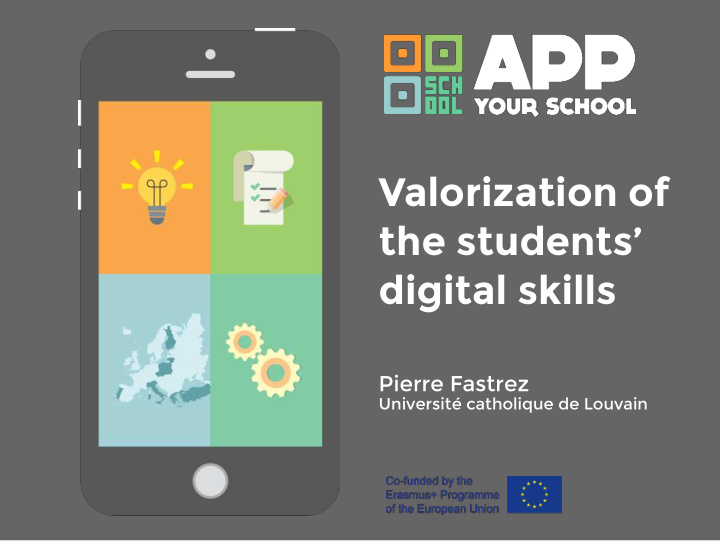



Valorization of the students’ digital skills Pierre Fastrez Université catholique de Louvain
Skills and competences in the D.A. School Digital atelier Extra- Active citizenship Participatory approach curricular through media (ICT) skills = media literacy competence Integration of ICT in schools Integrative Formative 2
Skills and competences in the D.A. Skill / capacity Competence Fixed Adaptable • • Simple Complex • • Reproducing Inventing • • Applying a predetermined Selecting and combining • • procedure knowledge and skills Learnt as-is Not learnt as-is • • Novel, non-stereotyped • Known situation • situation
Skills and competences in the DA Digital ateliers as both integrative and formative 1. Integrative: ➔ valorization • What do the youth bring to the digital ateliers in terms of extra-curricular abilities? • Digital (i.e. ICT-related) skills 2. Formative: ➔ assessment • What competences do the digital ateliers help develop in the youth? Media literacy competences • 4
D.A. description sheet “How do you plan to give voice to students to present or show their personal skills and knowledge?” Differentiate between ways of: Making the students’ existing extra-curricular • digital skills visible Making sure each student participates and is • engaged in the activities « Brainstorm, use apps (mentimeter, post.it), work in • pairs/in small groups/with captains, offer opportunities to comment their work… » Making what students have learned visible •
In the D.A. descriptions: Making the students’ existing extra- curricular digital skills visible Making sure each student participates and is engaged in the activities Making what students have learned visible
Work session Questions Procedure 1. Assemble pairs of • How do you plan to partners (A & B) give voice to students 2. Working together, ? answer the above questions for partner • How will students A’s D.A. show their personal • (partner B acts as an skills and knowledge? external point of view) • What skills? (if they 3. Do the opposite for can be listed in partner B’s D.A. advance) • How will you be able to identify them?
Pedagogical alignment in the digital ateliers Pierre Fastrez Université catholique de Louvain
Constructive alignment Three components of teaching need to be aligned: Intended learning outcomes • Design of learning activities • Assessment of learning • Cf. e.g. Biggs, J. (2014). Constructive alignment in university teaching. HERDSA Review of Higher Education, 1(5), 5–22.
Constructive alignment “In constructive alignment, we start with the outcomes we • intend students to learn, and align teaching and assessment to those outcomes. The outcome statements contain a learning activity, a verb, that • students need to perform to best achieve the outcome, such as “apply expectancy-value theory of motivation”, or “explain the concept of … “. That verb says what the relevant learning activities are that the students need to undertake in order to attain the intended learning outcome. Learning is constructed by what activities the students carry out; • learning is about what they do, not about what we teachers do. Likewise, assessment is about how well they achieve the • intended outcomes, not about how well they report back to us what we have told them or what they have read.” http:/ /www.johnbiggs.com.au/academic/constructive- alignment/
In theory Class aim(s) • What should the student be able to do by the end of the Learning class? outcome #1 • = [verb + object] • Criteria for outcome Assessment • Indicators for criteria #1 • Instruments for indicators • What should the students do to meet Activity #1 the criteria of outcome attainment?
In the AppYourSchool project D.A. aim(s) • What should the student be able to do by the end of the Learning activity? outcome #1 • Criteria for outcome Assessment • Indicators for criteria #1 • Instruments for indicators • What will the students do Activity #1 as part of the D.A. exploration ?
DA aims and outcomes D.A. general aim: • What media literacy competence(s) does the D.A. • seek to develop? Review your D.A.’s objective accordingly • Specific learning outcomes: • « By the end of activity x, the students will be • able to… » verb + object
Questions 1. How do the specific learning outcomes of each activity relate to the overal DA aim? 2. How do the specific learning outcomes relate to each activity, and to its assessment tools? Learning Assessment Activity #1 Outcome #1 #1 Learning Assessment DA aim Activity #2 Outcome #2 #2 Learning Assessment Activity #3 Outcome #3 #3
Constructive alignment in your DA DA aim Learning outcome Activity Assessment First activity in DA verb + criteria + ? ? description sheet object instruments Second activity in ‘Objectives’ in DA verb + criteria + ? ? DA description description sheet object instruments sheet Third activity in DA verb + criteria + ? ? description sheet object instruments
Constructive alignment in your DA 1. Assemble pairs of partners (A & B) 2. Working together, fill in the table for partner A’s D.A. (partner B acts as an external point of view) 3. Do the opposite for partner B’s D.A.
DA aim Learning outcome Activity Assessment First activity in DA description: ‘Objectives’ in DA description sheet Second activity in DA description: Third activity in DA description:
Recommend
More recommend